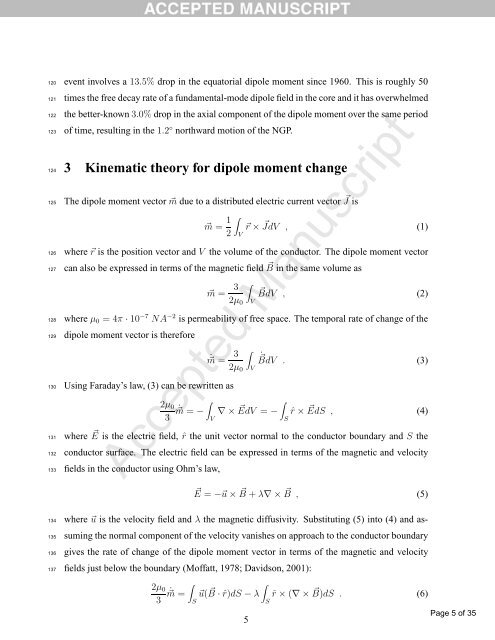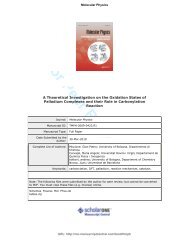Accepted Manuscript - TARA
Accepted Manuscript - TARA
Accepted Manuscript - TARA
Create successful ePaper yourself
Turn your PDF publications into a flip-book with our unique Google optimized e-Paper software.
120<br />
121<br />
122<br />
123<br />
124<br />
125<br />
126<br />
127<br />
128<br />
129<br />
130<br />
131<br />
132<br />
133<br />
event involves a 13.5% drop in the equatorial dipole moment since 1960. This is roughly 50<br />
times the free decay rate of a fundamental-mode dipole field in the core and it has overwhelmed<br />
the better-known 3.0% drop in the axial component of the dipole moment over the same period<br />
of time, resulting in the 1.2 ◦ northward motion of the NGP.<br />
3 Kinematic theory for dipole moment change<br />
The dipole moment vector ⃗m due to a distributed electric current vector ⃗ J is<br />
⃗m = 1 2<br />
∫<br />
V<br />
⃗r × ⃗ JdV , (1)<br />
where ⃗r is the position vector and V the volume of the conductor. The dipole moment vector<br />
can also be expressed in terms of the magnetic field B ⃗ in the same volume as<br />
⃗m = 3<br />
2µ 0<br />
∫V<br />
⃗BdV , (2)<br />
where µ 0 = 4π · 10 −7 NA −2 is permeability of free space. The temporal rate of change of the<br />
dipole moment vector is therefore<br />
˙⃗m = 3<br />
Using Faraday’s law, (3) can be rewritten as<br />
2µ 0<br />
3 ˙⃗m<br />
∫<br />
= −<br />
V<br />
2µ 0<br />
∫V<br />
∇ × EdV ⃗ ∫<br />
= −<br />
˙⃗BdV . (3)<br />
<strong>Accepted</strong> <strong>Manuscript</strong><br />
S<br />
ˆr × ⃗ EdS , (4)<br />
where ⃗ E is the electric field, ˆr the unit vector normal to the conductor boundary and S the<br />
conductor surface. The electric field can be expressed in terms of the magnetic and velocity<br />
fields in the conductor using Ohm’s law,<br />
⃗E = −⃗u × ⃗ B + λ∇ × ⃗ B , (5)<br />
134<br />
135<br />
136<br />
137<br />
where ⃗u is the velocity field and λ the magnetic diffusivity. Substituting (5) into (4) and as-<br />
suming the normal component of the velocity vanishes on approach to the conductor boundary<br />
gives the rate of change of the dipole moment vector in terms of the magnetic and velocity<br />
fields just below the boundary (Moffatt, 1978; Davidson, 2001):<br />
2µ 0<br />
3 ˙⃗m<br />
∫<br />
= ⃗u( ⃗ ∫<br />
B · ˆr)dS − λ ˆr × (∇ × B)dS ⃗ . (6)<br />
S<br />
S<br />
5<br />
Page 5 of 35
















